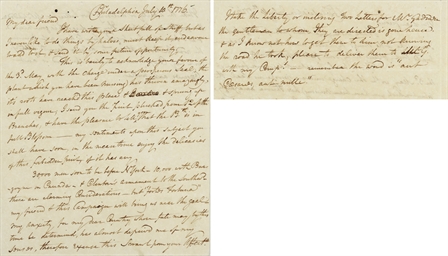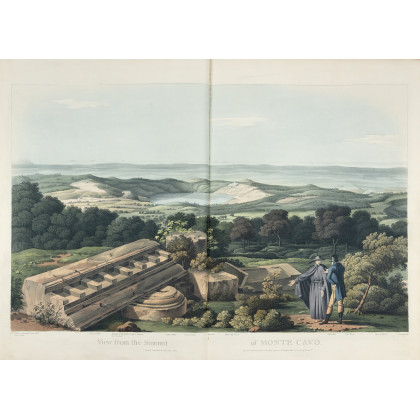MIDDLETON, Arthur (1742-1787), Signer (South Carolina) . Partly printed document signed ("Arthur Middleton"), countersigned by fellow Signer THOMAS HEYWARD ("Thomas Heyward Jun.," 1746-1809) and by HENRY LAURENS ("Henry Laurens," 1724-1792), CHARLES PINCKNEY ("Chas. Pinckney," 1757-1824), JOHN RUTLEDGE ("J. Rutledge," 1739-1800), Thomas Ferguson and Rawlins Lowndes (1721-1800). N.p., [Charleston, S.C.?], 1 March 1776. 1 page, oblong (5¼ x 9 3/8 in.), very discreet repairs along two horizontal folds, minor soiling. A decoratively printed certificate with scrolling woodcut borders, at the left a narrow band of typographical ornaments, text in different types, accomplished in manuscript in a neat italic hand. Headed, "South-Carolina," and certifying that "In Pursuance of the Resolutions of the Provincial Congress," William Brown is appointed "Captain in the Second Regiment of Riflemen in the Provincial Service." TWO SOUTH CAROLINA SIGNERS, INCLUDING ARTHUR MIDDLETON SIGN A 1776 MILITIA APPOINTMENT, WITH THE ADDITIONAL SIGNATURES OF AN ARRAY OF SOUTH CAROLINA PATRIOTS A document which links an exceptional constellation of South Carolina Revolutionary War patriots: two of them Signers of the Declaration, three future Governors and one President of Congress. Middleton, the son of one of the largest South Carolina landholders, was educated in England at Hackney School, then Cambridge, and read law at the Middle Temple in London. But he was quick to embrace the revolutionary cause on his return to South Carolina, and became one of the most radical members of the provincial assembly, advocating the seizure of royal arms, the defence of the port of Charleston and the tarring and feathering of loyalists. He was elected to the Continental Congress in February 1776 and, a little over a month after signing this militia appointment, Middleton was one of those who planned and carried out a daring raid on the Royal storehouses, seizing powder and munitions to arm the provincial forces. During this same period he served on the committee which drafted a new state consititution, then traveled to Philadelphia, taking his seat on May 20 (a few weeks after this document) and was present for the critical deliberations surrounding the vote, in early July, for independence. The document's signatories comprise a remarkable cross-section of South Carolina's revolutionary leaders. Other signers include: John Rutledge, a delegate to the Continental Congress (1774-1776, 1782-1783), President and then Governor of South Carolina; Charles Pinckney, who served in the Continental Congress (1774-1787) and in the Constitutional Convention, and as South Carolina's Congressman, Senator and Governor. From 1801 to 1805, Pinckney was minister to Spain, and was involved in the important negotiations associated with the Louisiana Purchase. Henry Laurens served in the state assembly from 1757 to 1774, and as the President of his state's Committee of Safety; he was elected to the Continental Congress (1777-1779) and served as President of Congress from November 1777 to September 1778. Thomas Heyward also was a member of the Council of Safety and served in the Continental Congress from 1776-1778 and affixed his signature to the engrossed Declaration of Independence with fellow South Carolinians Arthur Middleton Thomas Lynch, and Edward Rutledge (1749-1800). Rawlins Lowndes was a member of the First and Second Provincial Congress, and of the Council of Safety, had served a terms as South Carolina's Governor in 1778-1779, and was one of the members of the committee that drafted the state constitution. Like Middleton, he was captured by the British at the fall of Charleston.
MIDDLETON, Arthur (1742-1787), Signer (South Carolina) . Partly printed document signed ("Arthur Middleton"), countersigned by fellow Signer THOMAS HEYWARD ("Thomas Heyward Jun.," 1746-1809) and by HENRY LAURENS ("Henry Laurens," 1724-1792), CHARLES PINCKNEY ("Chas. Pinckney," 1757-1824), JOHN RUTLEDGE ("J. Rutledge," 1739-1800), Thomas Ferguson and Rawlins Lowndes (1721-1800). N.p., [Charleston, S.C.?], 1 March 1776. 1 page, oblong (5¼ x 9 3/8 in.), very discreet repairs along two horizontal folds, minor soiling. A decoratively printed certificate with scrolling woodcut borders, at the left a narrow band of typographical ornaments, text in different types, accomplished in manuscript in a neat italic hand. Headed, "South-Carolina," and certifying that "In Pursuance of the Resolutions of the Provincial Congress," William Brown is appointed "Captain in the Second Regiment of Riflemen in the Provincial Service." TWO SOUTH CAROLINA SIGNERS, INCLUDING ARTHUR MIDDLETON SIGN A 1776 MILITIA APPOINTMENT, WITH THE ADDITIONAL SIGNATURES OF AN ARRAY OF SOUTH CAROLINA PATRIOTS A document which links an exceptional constellation of South Carolina Revolutionary War patriots: two of them Signers of the Declaration, three future Governors and one President of Congress. Middleton, the son of one of the largest South Carolina landholders, was educated in England at Hackney School, then Cambridge, and read law at the Middle Temple in London. But he was quick to embrace the revolutionary cause on his return to South Carolina, and became one of the most radical members of the provincial assembly, advocating the seizure of royal arms, the defence of the port of Charleston and the tarring and feathering of loyalists. He was elected to the Continental Congress in February 1776 and, a little over a month after signing this militia appointment, Middleton was one of those who planned and carried out a daring raid on the Royal storehouses, seizing powder and munitions to arm the provincial forces. During this same period he served on the committee which drafted a new state consititution, then traveled to Philadelphia, taking his seat on May 20 (a few weeks after this document) and was present for the critical deliberations surrounding the vote, in early July, for independence. The document's signatories comprise a remarkable cross-section of South Carolina's revolutionary leaders. Other signers include: John Rutledge, a delegate to the Continental Congress (1774-1776, 1782-1783), President and then Governor of South Carolina; Charles Pinckney, who served in the Continental Congress (1774-1787) and in the Constitutional Convention, and as South Carolina's Congressman, Senator and Governor. From 1801 to 1805, Pinckney was minister to Spain, and was involved in the important negotiations associated with the Louisiana Purchase. Henry Laurens served in the state assembly from 1757 to 1774, and as the President of his state's Committee of Safety; he was elected to the Continental Congress (1777-1779) and served as President of Congress from November 1777 to September 1778. Thomas Heyward also was a member of the Council of Safety and served in the Continental Congress from 1776-1778 and affixed his signature to the engrossed Declaration of Independence with fellow South Carolinians Arthur Middleton Thomas Lynch, and Edward Rutledge (1749-1800). Rawlins Lowndes was a member of the First and Second Provincial Congress, and of the Council of Safety, had served a terms as South Carolina's Governor in 1778-1779, and was one of the members of the committee that drafted the state constitution. Like Middleton, he was captured by the British at the fall of Charleston.










Try LotSearch and its premium features for 7 days - without any costs!
Be notified automatically about new items in upcoming auctions.
Create an alert